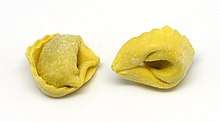Tortellini
Tortellini are ring-shaped pasta originally from the Italian region of Emilia (in particular Bologna and Modena). They are sometimes also described as "navel shaped", hence their alternative name of "belly button" (ombelico), and bear a strong resemblance to a large wonton.[1] Traditionally they are stuffed with a mix of meat (pork loin, raw prosciutto, Mortadella), Parmigiano Reggiano cheese, egg and nutmeg and served in capon broth (in brodo di cappone).[2]
 The distinctive shape of tortellini | |
| Alternative names | Belly button |
|---|---|
| Type | Pasta, Dumplings |
| Place of origin | Italy |
| Region or state | Emilia-Romagna |
| Variations | Tortelloni |
While in the area of origin they are usually sold fresh or home-made, industrially packed, dried and refrigerated or frozen tortellini appear in many locations around the world, especially where there are large Italian communities.
Origins


The origin of tortellini is disputed; both Bologna and Modena, cities in Italy's Emilia-Romagna region, claim to be its birthplace.[3] OxfordDictionaries.com traces the etymology of tortellini to the diminutive form of tortello, itself a diminutive of torta. Both reference cake.[4] The recipe for a dish called torteletti appears in 1570 from Bartolomeo Scappi. Vincenzo Tanara's writings in the mid-17th century may be responsible for the pasta's renaming to tortellini. In the 1800s, legends sprang up to explain the recipe's origins, offering a compromise. Castelfranco Emilia, located between Bologna and Modena,[3] is featured in one legend, in which Venus stays at an inn. Overcome by her beauty, the innkeeper spies on her through a keyhole, through which he can only see her navel. He is inspired to create a pasta in this shape. In honor of this legend, an annual festival is held in Castelfranco Emilia.[5] Another legend posits that the shape comes from Modena's architecture, which resembles a turtle.[6]

Comparison to tortelloni
Tortelloni is pasta in a similar shape, but larger, typically 5 g, vs. 2 g for tortellini,[7] and with the extremities closed differently. While tortellini have a meat-based filling, tortelloni are filled with ricotta and sometimes with parsley or spinach. Moreover, while tortellini are traditionally cooked in and served with broth, tortelloni are cooked in water, stir-fried (traditionally with butter and sage) and served dry.
Production process
Production steps
- Knead the ground pork, along with the other ingredients, to get the stuffing
- Knead the flour and eggs to make the dough
- Flattening of the dough
- Cut the flattened dough into squares
- Depositing the portion of stuffing on each square of dough
- Shape the tortellino

Equipment
Homemade
- chopping board
- knife
- rolling pin
- Dough Rolling Board
Industry
- mincer
- kneading machine
- sheeter
- Forming machine (tortellini machine)
See also
References
- The Oxford Companion to Italian Food by Gillian Riley
- "Official recipe of the tortellino, as it was registered at the Chamber of Commerce of Bologna in 1974" (PDF). www.confraternitadeltortellino.it (in Italian). Retrieved 2018-12-31.
- Zanini De Vita, Oretta (2009). Encyclopedia of Pasta. University of California Press. pp. 297–299. ISBN 9780520944718.
- "The meaning of pasta names". OxfordDictionaries.com. Retrieved 12 May 2018.
- Poggioli, Sylvia (27 August 2013). "Tortellini, The Dumpling Inspired By Venus' Navel". NPR. Retrieved 12 May 2018.
- Marsden, Shelley (4 December 2015). "The secret to tortellini, Modena's special pasta". The Daily Telegraph. Retrieved 12 May 2018.
- Barilla US (manufacturer) FAQ
External links
| Wikimedia Commons has media related to Tortellini. |
- Hand-made tortellini original recipe by a cooking school located in Bologna
- Hand-made tortellini in brodo how-to, with video
- Tortellini production video
- From the rolled out egg-rich and flour pasta dough, stuffed with a mix of meat, the hand made production of tortellini (navel-shaped pasta) - video